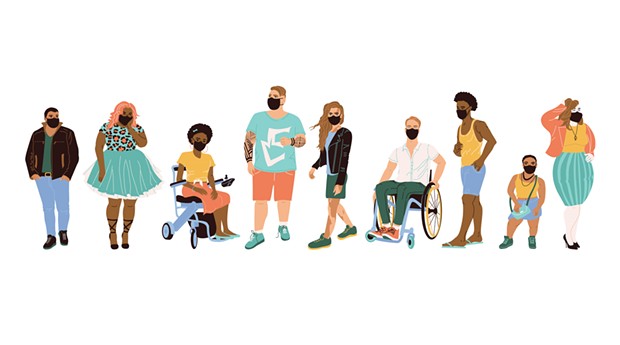[
{
"name": "Top Stories Video Pair",
"insertPoint": "7",
"component": "17087298",
"parentWrapperClass": "fdn-ads-inline-content-block",
"requiredCountToDisplay": "1"
}
]
"We're all going to get it."
I keep hearing the phrase. Sometimes, it's said with a sigh by someone who has no choice but to work face-to-face with the public, resigned to what seems inevitable when depending on strangers to consider their safety. But more often, I hear it spoken or see it typed in comments with an air of dismissive fatalism. The passive motto with which one shrugs off as pointless one of the layers of protection that slow the spread of COVID-19 and its wildfire variant Omicron.
It is indeed exhausting toting and wearing masks all the time, trying to hear one another through the layers, holding off celebrations and seeing far-flung loved ones. No argument there. And it's awful saying no to kids who want to hang out with friends unmasked, especially when the vaccine was supposed to have us back to sleepovers and birthday parties. And Omicron's ability to sneak past the cloth masks, vaccines and boosters we've come to rely on can make us want to throw up our hands, toss them aside and say, "We're all going to get it."
But the unspoken and sometimes unconscious calculus of throwing caution to the wind is mostly about our own expected outcomes. If I'm healthy, vaccinated and boosted, I'll probably be fine. The symptoms will likely be "mild," at least compared to the brutal kidney failure, ravaged lungs and intubation experienced by those who get the worst of it. But it's not only our own health on the line. The most vulnerable people in our community — our elders, those with compromised immune systems and health issues, and those without the option to vaccinate — are depending on us to slow the spread of the virus, to keep them safe from those harshest outcomes.
Those people, if they don't include us, can seem distant when we're making the million safety decisions left to us in a given day. People with comorbidities. People with bad genes, bad habits, bad health, bad choices, bad luck.
But 2018 Public Health data reports 7,359 people in our county with diabetes and another 40,531 with cardiovascular disease. According to County Health Rankings and Roadmaps, nearly a quarter of Humboldt County residents are obese and an estimated 17 percent smoke. Only 63 percent of us are vaccinated, leaving more than a third — including kids younger than 5 at a time when cases among children are skyrocketing — without that crucial shield from the most brutal effects of infection. (Nationally, the unvaccinated are eight times more likely to be hospitalized while Public Health reports locally that unvaccinated residents are 13 times as likely to be hospitalized with COVID-19.) These are only a handful of the myriad risk factors and chances are some folks in your life are carrying one or more of them. The vulnerable, if they don't already include us, are never very far.
Imagine what a dismissive, "We're all going to get it anyway," sounds like to someone with decreased kidney function or HIV, someone with a disability that makes infection a far more dangerous prospect. Imagine how rattling off the percentage of deaths like it's a reason to relax sounds to an elder or someone who has an immunocompromised child. What number do we have to hit — beyond the 800,000 we've already lost nationally and 128 locally — for it to be worrisome enough? Which people do we have to lose to make it a big deal? Because when we decide those in imperfect health are expendable, we veer into eugenics.
How does saying, "We're all going to get it," and hosting an unmasked indoor gathering come off to a teacher struggling to cover classes at a school where staffing is down to skeleton crews and new exposures are popping up daily? Imagine how it rings in the ears of hospital staff trying to keep up with more patients with fewer hands to help them. Scoff at the choices of the willfully unvaccinated if your empathy is tapped out but the impact of further spread and more sick and dying people remains.
Allowing ourselves to become desensitized to sickness and death of others isn't good for our collective safety or our individual souls.
If we were still doing color-coded tiers, we'd be neon. But the potential outcomes of restrictions, mandates or full lockdowns are locked in the hypothetical, given the lack of public or political will to change what businesses will remain open or what gatherings are allowed based on the spread of the virus. Instead, COVID sets its own closures, with infection and illness sidelining staff in every industry. And we're left to navigate our own choices and the attitude that guides them — for this and whatever variant springs up next.
We might get it. But we can still fight — with the best masking we can manage, with avoiding gatherings, by getting vaccinated and distancing, by testing and quarantining — for everyone who can't afford to get it.
Jennifer Fumiko Cahill (she/her) is the arts and features editor at the Journal. Reach her at 442-1400, extension 320, or [email protected]. Follow her on Twitter @JFumikoCahill.
Comments (4)
Showing 1-4 of 4
more from the author
-
CPH Protests and Doing Good on Cinco de Mayo
- May 5, 2024
-
Failed Leadership
- May 2, 2024
-
Mexican Restaurants Support English Express for Cinco de Mayo<
- May 2, 2024
- More »
Latest in Editorial
Readers also liked…
-
Failed Leadership
- May 2, 2024

































